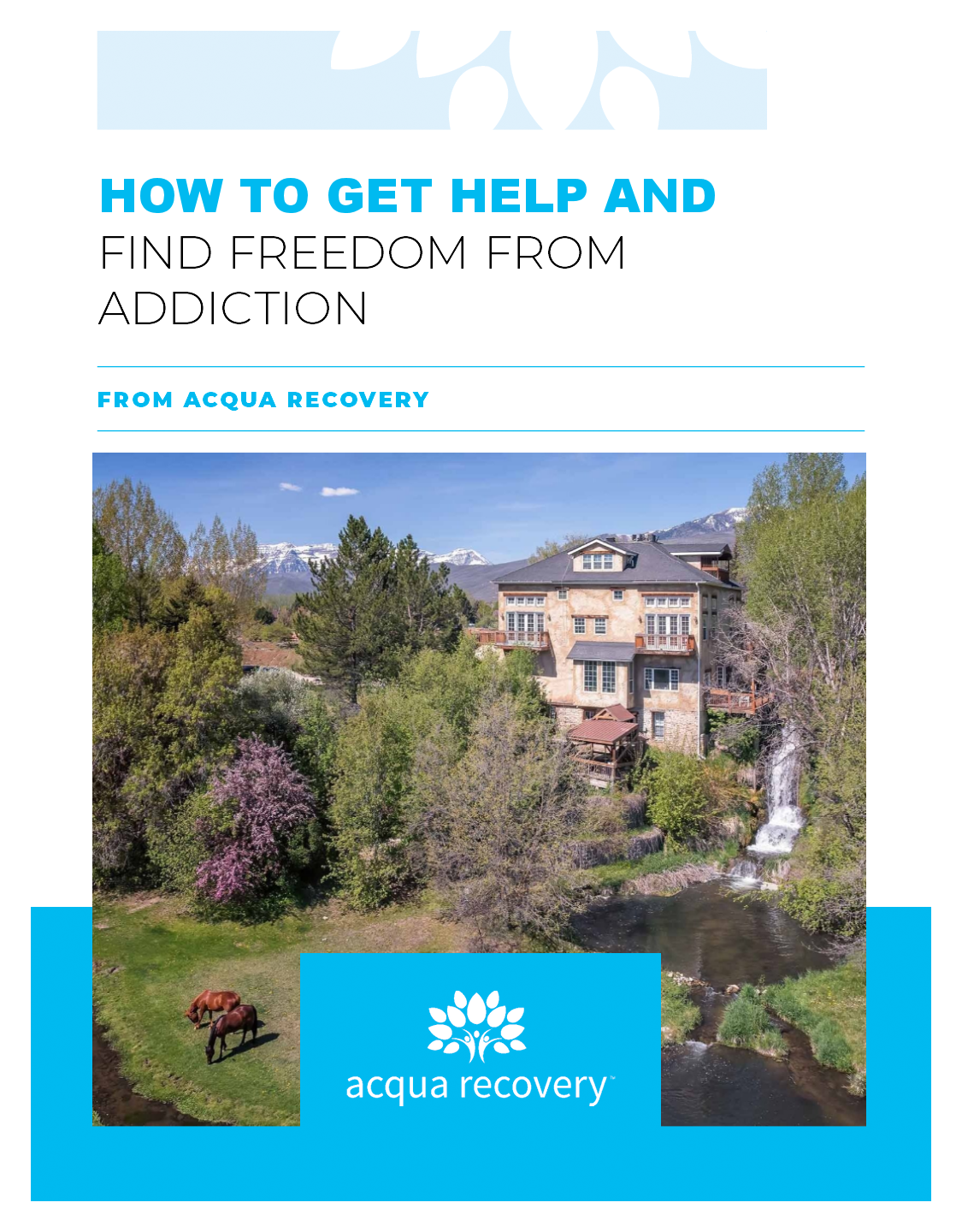Childhood is meant to be a time of innocence, joy, and discovery, yet for many, it is marred by experiences that are anything but idyllic. Recent studies reveal a staggering truth: nearly two-thirds of adults report experiencing at least one adverse childhood event, and those who endure such trauma are significantly more likely to grapple with addiction later in life.
This intersection between childhood trauma and addiction is a critical focus at Acqua Recovery, where we believe that healing must begin at the root of these complex issues. With locations in Utah and Colorado, Acqua Recovery is dedicated to offering compassionate, evidence-based treatment that addresses the scars of the past and the present challenges. By understanding and treating the emotional wounds of trauma, we empower individuals to break free from the cycle of addiction, fostering a path to lifelong recovery and resilience.
Defining Childhood Trauma
Childhood trauma refers to distressing experiences that occur before an individual reaches adulthood. These experiences can be emotional, physical, or sexual in nature and may involve direct experiences of abuse or neglect or witnessing violence.
To understand the full impact of childhood trauma, it’s essential to define the various forms it can take. Different types of trauma can evoke different responses, significantly impacting a child’s development and psychological well-being. The effects of trauma can ripple through a child’s life, influencing their ability to form healthy relationships, succeed academically, and navigate the complexities of adult life.
Types of Childhood Trauma
Childhood trauma can be classified into several categories, including:
- Physical abuse: This involves causing bodily harm to a child through violence.
- Emotional abuse: This encompasses behaviors that harm a child’s self-worth or emotional well-being.
- Sexual abuse: Any sexual act performed with a child, whether through coercion or manipulation.
- Neglect: The failure to provide for a child’s basic needs, including emotional support, education, and healthcare.
- Witnessing domestic violence: Children who see violent acts in the home may also experience trauma.
Each type has unique characteristics that can lead to specific psychological outcomes. The severity and duration of the trauma are also critical factors in determining its long-term effects. For instance, a child who experiences prolonged neglect may struggle with trust and attachment issues later in life, while one who witnesses domestic violence might develop a heightened sense of anxiety or fear in interpersonal relationships.
The Impact of Childhood Trauma on Mental Health
The consequences of childhood trauma can be far-reaching. Children who experience trauma may develop a range of mental health disorders, including anxiety, depression, post-traumatic stress disorder (PTSD), dual diagnosis, and other emotional challenges. This impact can extend into adulthood, influencing relationships, work performance, and overall quality of life. Research indicates that individuals with a history of childhood trauma are at a higher risk for developing chronic health conditions, such as heart disease and diabetes, due to the long-term effects of stress on the body.
Moreover, the emotional fallout from trauma can manifest in behavioral issues, such as aggression, withdrawal, or self-destructive behaviors. This paper will further explore how trauma sets the stage for addiction as a coping mechanism for these emotional difficulties. Additionally, the social environment plays a crucial role in either mitigating or exacerbating these effects; supportive relationships and therapeutic interventions can significantly alter the trajectory of a child’s recovery from trauma, highlighting the importance of early intervention and community support systems in fostering resilience.
The Connection Between Trauma and Addiction
 The link between childhood trauma and addiction is well documented in psychological research. Many individuals who face traumatic experiences turn to substances as a way to numb emotional pain or escape from their realities.
The link between childhood trauma and addiction is well documented in psychological research. Many individuals who face traumatic experiences turn to substances as a way to numb emotional pain or escape from their realities.
Understanding this connection is essential for addressing addiction from a root-cause perspective rather than merely focusing on the symptoms.
Psychological Responses to Trauma
When a child experiences trauma, their brain undergoes significant changes in response to stress. These changes can alter their emotional regulation, leading to various coping mechanisms.
For instance, trauma can trigger an increased state of hyperarousal, where a child remains in a heightened alert state. This perpetual state may prompt individuals, particularly those with unresolved trauma, to seek substances that soothe psychological distress, leading to a potential addiction.
The impact of trauma can extend beyond immediate emotional responses. Neurobiological studies have shown that traumatic experiences can affect the brain’s reward pathways, making individuals more vulnerable to seeking out substances that provide quick relief. This alteration in brain chemistry can create a feedback loop where the individual feels compelled to use substances not only to escape their pain but also to regain a sense of normalcy in their emotional state.
The Role of Coping Mechanisms in Addiction
Many affected individuals may turn to alcohol, drugs, or other compulsive behaviors as a means to cope with unprocessed trauma. These substances can alter mood and provide a temporary escape from emotional pain. Yet, reliance on these substances often leads to a cycle of dependency, further complicating the individual’s mental health.
Understanding these coping mechanisms offers insight into why some individuals are more susceptible to addiction, ultimately highlighting the need for comprehensive trauma-informed treatment approaches. Therapeutic interventions that address both trauma and addiction simultaneously can be particularly effective. Techniques such as Eye Movement Desensitization and Reprocessing (EMDR) and Cognitive Behavioral Therapy (CBT) can help individuals process their traumatic experiences while also developing healthier coping strategies. By fostering resilience and emotional regulation, these treatments can pave the way for recovery and a more fulfilling life, free from the chains of addiction.
The Science Behind Trauma and Addiction
Delving deeper into the neurobiological aspects of trauma uncovers how these experiences can shift brain function, making addiction more likely. The science reveals that trauma can lead to alterations in brain structures and functions, particularly those responsible for stress responses and impulse control.
Neurological Changes Due to Trauma
Trauma affects the brain’s architecture, particularly the amygdala and prefrontal cortex, areas responsible for processing emotions and decision-making. When these areas are impacted, individuals may struggle to respond to stress effectively or control impulses, paving the way for addictive behaviors as an unhealthy coping mechanism.
Furthermore, chronic trauma can affect the brain’s reward system, often leading individuals to turn to substances in search of dopamine—a chemical that promotes feelings of pleasure—to compensate for the emotional void created by traumatic experiences. This cycle of seeking relief through substance use can create a feedback loop, where the temporary escape from pain reinforces the behavior, making it increasingly difficult to break free from addiction.
The Influence of Trauma on Substance Abuse
Research indicates that individuals with a history of childhood trauma are at a higher risk for developing substance use disorders. The distress from unresolved trauma can drive individuals to substances as a form of relief or escape.
This connection illustrates the pressing need for trauma-informed approaches in addiction treatment, focusing not just on the substance use itself but also on the underlying trauma that contributes to the addiction cycle. Such approaches emphasize the importance of creating a safe and supportive environment where individuals can process their traumatic experiences, fostering resilience and healthier coping strategies. By integrating therapy modalities, practitioners can help clients address the root causes of their addiction, ultimately leading to more sustainable recovery outcomes.
Treatment Approaches for Trauma and Addiction
Effectively addressing both trauma and addiction requires specialized treatment strategies that recognize the interconnected nature of these issues. This approach entails holistic interventions that can provide integrated care for individuals struggling with both challenges.
Trauma-Informed Care in Addiction Treatment
Trauma-informed care emphasizes understanding, recognizing, and responding to the effects of all types of trauma. This method involves creating a safe environment for individuals, ensuring they feel secure as they navigate their recovery journey.
Additionally, trauma-informed care aims to empower individuals by validating their experiences and encouraging their active participation in the healing process. This approach can lead to more effective recovery, reducing the likelihood of relapse. By fostering a supportive atmosphere, practitioners can help clients build resilience and develop coping strategies that are essential for long-term recovery.
Therapeutic Interventions for Trauma and Addiction
Various therapeutic approaches can be utilized to address both trauma and addiction effectively. Some of these include:
- Cognitive Behavioral Therapy (CBT): This therapy helps individuals identify and change negative thought patterns and behaviors associated with trauma and addiction.
- Eye Movement Desensitization and Reprocessing (EMDR): This therapy is specifically effective for PTSD, enabling clients to process and heal from trauma by using eye movements.
- Dialectical Behavior Therapy (DBT): DBT combines cognitive-behavioral techniques with mindfulness strategies, helping individuals manage emotions and reduce self-destructive behaviors.
Implementation of such therapeutic interventions can create a comprehensive framework to address the multifaceted needs of individuals facing trauma and addiction. Furthermore, integrating group therapy sessions can provide a sense of community and shared experience, allowing individuals to connect with others who understand their struggles. This social support can be crucial in reinforcing the healing process, as participants often find solace in knowing they are not alone in their journey.
Moreover, incorporating holistic practices such as mindfulness meditation, yoga, and art therapy can enhance traditional therapeutic methods. These practices promote self-awareness and emotional regulation, allowing individuals to explore their feelings in a safe and creative manner. By addressing both the psychological and physical aspects of trauma and addiction, these combined approaches can lead to more sustainable recovery outcomes, fostering a deeper understanding of oneself and the challenges faced along the path to healing.
Prevention and Early Intervention Strategies
Addressing the challenges of childhood trauma and addiction requires an emphasis on prevention and early intervention. Recognizing signs of trauma in children is critical for initiating support and resources before serious problems develop.
Recognizing Signs of Trauma in Children
Parents, caregivers, and educators play a vital role in identifying signs of trauma. Common symptoms may include:
- Changes in behavior, such as aggression or withdrawal
- Difficulty concentrating or learning
- Increased anxiety or fearfulness
- Physical symptoms such as headaches or stomachaches without an apparent medical cause
Awareness and training for adults working with children can facilitate early detection of trauma, allowing for quicker intervention and support. These adults need to understand that trauma can manifest in various ways, and each child’s response may differ based on their unique experiences and coping mechanisms. For instance, some children may exhibit hyperactivity or impulsivity as a way to cope with their distress, while others may become increasingly withdrawn. This variability underscores the importance of a nuanced approach to recognizing and addressing trauma.
Implementing Early Intervention Measures
Early intervention strategies may take various forms, including counseling, support groups, and educational programs designed to help children and families cope with trauma. Integrating these measures can provide a safety net, preventing the development of more severe mental health issues or addiction later in life. Schools can play a pivotal role by incorporating social-emotional learning (SEL) programs that teach children how to manage their emotions, build resilience, and develop healthy relationships. Community organizations can offer workshops and resources that empower parents with the tools they need to support their children effectively.
Collaboration among mental health professionals, educators, and community leaders is crucial in creating a comprehensive support system. By fostering partnerships, communities can ensure that children have access to a continuum of care, which may include therapy, mentorship, and recreational activities that promote healing and connection. Ultimately, by prioritizing early intervention, communities can work towards breaking the cycle of trauma and addiction, fostering healthier outcomes for future generations.
Learn More about Trauma and Addiction Treatment at Acqua Recovery
 In the journey of understanding and healing from addiction, acknowledging the profound impact of childhood trauma is a vital step. At Acqua Recovery, we recognize that confronting these deep-seated issues is essential to achieving genuine, lasting recovery. Our facilities in Utah and Colorado are equipped with compassionate and evidence-based approaches that cater to the unique needs of each individual.
In the journey of understanding and healing from addiction, acknowledging the profound impact of childhood trauma is a vital step. At Acqua Recovery, we recognize that confronting these deep-seated issues is essential to achieving genuine, lasting recovery. Our facilities in Utah and Colorado are equipped with compassionate and evidence-based approaches that cater to the unique needs of each individual.
By addressing the emotional scars of the past alongside present addiction challenges, we pave the way for transformative healing and resilience. If you or someone you know is struggling with the intertwined challenges of trauma and addiction, remember that seeking help is a courageous and hopeful step toward recovery. At Acqua Recovery, we’re here to support every step of that journey, offering a beacon of hope and a pathway to a brighter, healthier future. Contact us today to begin your healing journey.











